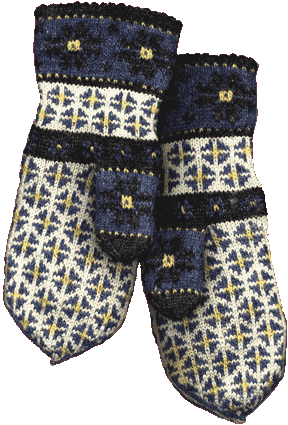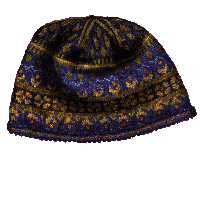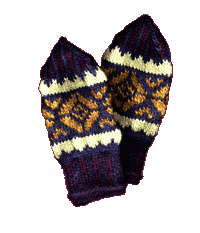 |
home
 |
home
| One of the many things I do is to knit. My Latvian grandma taught me how to knit when I was a kid. Then when I was older, my mom found me a book that had English translations on how to knit traditional Latvian mittens. I taught myself and since then have made many pairs which I give away to friends and family. Latvians seem to be obsessed with mittens. I don't know any other cultural traditions that focus so much on one type of clothing. I know it's cold in Latvia but there are other cold places in the world which don't have the same obsession. Here is a brief and fascinating historical accounting of Latvian mittens. |
 |
LATVIESU RAKSTAINIE CIMDI Mirdza Slava c. 1990 |
|||
      |
Mittens and gloves preserved from old times are testimony to their authors' inventiveness who showed great skill and artistry in colour composition and shades. It is as if the women had been trying to do their best and competing among themselves to create more imaginative ornaments. Gloves and best mittens were subjected to a wide social judgement, and this fact urged the authors to produce a more creative result. Best mittens were knitted to be given as presents not only on weddings where they dominated among knitted socks and other things. In the 19th century they were given to godparents and the clergyman on christening the children. After the first childbirth mittens were given to family relations. When the child was taken to the church for the first time, a pair of mittens was left in the church robing-room. When young people started to prepare for confirmation, the clergyman received a good pair of ornamented mittens. If a maiden gave a pair of mittens to a lad, it was taken as a sign of engagement. Earlier they said in Kurzeme, 'the lad has received the motley mittens', instead of saying 'the maiden and the lad have been engaged'. According to the old traditions mittens were to be given on other important occasions as well, like to the blacksmith when the horse was shod for the first time. The latter tradition was still observed at the beginning of the 20th century. If maidens were taken out for a ride, they had to give a pair of mittens to the lads for giving them a ride. Today it is very rare that, observing an old tradition, elderly women knit funeral mittens to be given to the grave diggers, the clergyman and the coffin bearers. In earlier time when coffins were made by local craftsmen, mittens were given to the latter for their work. There is evidence from all ancient ethnographic parts of Latvia about the making of 'the funeral portion' but today neither special ornaments nor colours are chosen for the mittens to be given at funerals. A 90-year-old narrator living near Alsunga had knitted three kinds of funeral mittens for various times of the year: black with white ornaments for winter, greyish brown with white for autumn and spring, and brown with yellow and green ornaments for summer. In the beginning of the 20th century there was a tradition in some districts to give the cross-bearer a pair of black or simply dark gloves ornamented with white crosses. If the deceased was a young person, the cross-bearer received white gloves. The tradition of giving white gloves seems to have been preserved from the times when the white bridegroom's gloves were given to the cross-bearer at the funeral of a virgin. In our time all these customs have nearly fallen into oblivion or have been greatly transformed. It was an ancient wedding tradition to give numerous mittens as presents starting already some time before the wedding. If the suitor was considered acceptable, the bride presented mittens to him and the matchmakers. In the period of engagement the bride gave 'motley mittens' to her beloved who wore them on the wedding day. Another pair went to the bridegroom on the way to the church, one more ---- to the clergyman when he entered the names of the engaged on the wedding list. In the time of feudal serfdom the farm-labourers and the people serving at the country squire's estate had to ask for the permission to marry; the bride to-be had to show before the squire and present him a pair of mittens. The brides dowry was usually carried to the new husband's house on Thursday or Saturday before the wedding day. The bride gave the dowry carriers a pair of gloves that were fastened to the carrier's hat. The dowry cow's horns were adorned with mittens, and a pair of mittens was to be given for letting the cows into the shed. Sometimes mittens were given to the woman who helped the bride to put on her bridal veil. The custom was particularly observed in Alsunga where the bride's head-dress was wrapped in the married woman's kerchief (called 'linkainis'). A brightly coloured ornamented pair of mittens was left for the church warden after the wedding ceremony and one also on the altar for the organ player. In the second half of the 19th century the latter traditions were not frequently observed because the older narrators could not recall them any more when scientific expeditions were made. Mittens were to be given to the man who helped the bride out of the carriage or the sleigh when she returned from the church. A pair of mittens was thrown into the yard on approaching the new husband's house. When the bride was shown into the house, she left a pair of mittens near the stove. The distribution of the marriage dowry on the wedding-day evening after changing the bride's head-dress was the custom of Augszeme, Latgale and Vidzeme. In Kurzeme and some parts of Vidzeme it was done in the new husband's house on the day after the wedding. The time was chosen depending on the length of festivities and the place where the newlyweds were going to live. The young wife distributed mittens and other presents to her mother-in-law, father-in-law, brothers- and sisters-in-law, the wedding sponsors and the musicians. On Saturday in the end of the wedding week the young wife went to her mother-in-law's bathhouse to wash herself where again she to 'throw' mittens and girdles. Mittens were placed on the bathhouse threshold, seating shelf and stove; girdles were wound around birch besoms to ensure lucky childbearing. Up to the middle of the 19th century people believed in the magic powers of 'mittens throwing'. Therefore the young wife had to leave a pair of mittens in the shed, the granary and the barn, on the draw-well and in other places when she entered her husband's house for the first time. This was believed to ensure success in housework and bring prosperity. By the end of the 19th century the custom had mostly disappeared but the tradition of giving mittens as presents for various services has been preserved till out day. It should also be remarked that mittens are now often replaced by various souvenirs. |